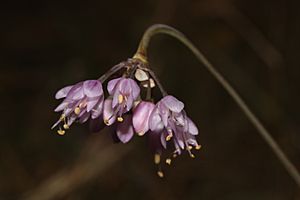Nodding onion facts for kids
Quick facts for kids Nodding onion |
|
|---|---|
 |
|
| A plant in bloom in Anacortes, Washington | |
| Scientific classification | |
| Synonyms | |
|
The Nodding onion (scientific name: Allium cernuum) is a type of plant that lives for many years. It is also known as lady's leek. This plant belongs to the Allium family, which includes common onions and garlic.
You can find Nodding onions growing in many places. They like dry woods, rocky areas, and prairies. This plant grows across a large part of North America. It is found in much of the United States, Canada, and Mexico.
In the United States, it grows in the Appalachian Mountains, the Great Lakes Region, and the Ohio and Tennessee River Valleys. It is also found in the Ozarks and the Rocky and Cascade Mountains in the West. In Canada, it grows from Ontario to British Columbia.
Contents
What Does Nodding Onion Look Like?
The Nodding onion is a plant that comes back every year. It grows from a special underground part called a bulb. This bulb is shaped like a cone and is not covered by a papery skin.
From the bulb, thin, flat leaves grow. They look a bit like grass and are about 2 to 4 millimeters wide. Each grown-up bulb produces one flower stem. This stem has a unique feature: it bends downwards at the top.
At the end of the bending stem, you'll see a cluster of flowers. This cluster is called an umbel. The flowers are bell-shaped and can be white or pink. They usually bloom in July and August. Each flower is about 5 millimeters across. They have yellow pollen and yellow anthers. Unlike some other onion plants, the Nodding onion does not grow small bulbs in its flower cluster.
After the flowers bloom, they turn into round, crested fruits. These fruits later open up to show dark, shiny seeds inside.
Where Does Nodding Onion Grow?
Nodding onions can grow in many different environments. They are found in deciduous woodlands, which are forests where trees lose their leaves in autumn. They also grow in open grasslands.
Even though this plant is found in many places, it doesn't grow everywhere. In the southern parts of North America, it mostly grows in mountains. In other areas, it might only be found in small, separate groups. For example, it is not found in North Dakota or most of the Great Plains states. In Minnesota, the Nodding onion is considered a threatened species. This means its populations are at risk.
How People Use Nodding Onion
The Nodding onion is an onion that you can eat. It has a strong onion flavor and people have often used it in cooking.
People also grow Nodding onions in their gardens. They are popular because of their interesting flowers that nod downwards. These flowers can be white, pink, or a deep maroon color. The plant is quite tough and can survive cold winters. It grows well in many different climates.
Similar Plants to Nodding Onion
Some other plants look a lot like Nodding onion. These include other types of Allium plants, such as wild garlic, field garlic, and wild leek.
It's very important to be careful when looking for wild onions. If you find a plant that looks like an onion but doesn't smell like one, it might be a poisonous plant. For example, deathcamas looks similar but is very dangerous to eat. Always make sure a plant has the strong, familiar smell of onion before you think about eating it.
See also
 In Spanish: Allium cernuum para niños
In Spanish: Allium cernuum para niños




